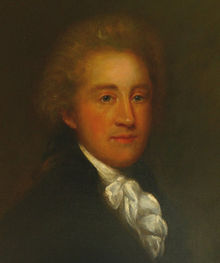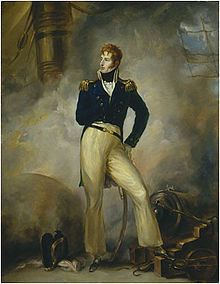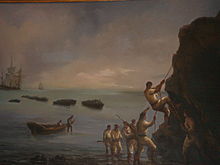- Thomas Cochrane, 10th Earl of Dundonald
-
The Right Honourable
The Earl of Dundonald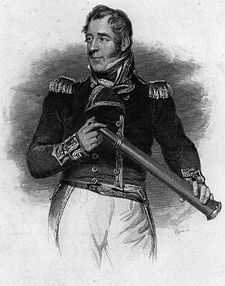
Engraving of Lord Dundonald, based on a painting by James Ramsay (1866)Nickname The Wolf of the Seas Born 14 December 1775
Annsfield, near Hamilton, South Lanarkshire, ScotlandDied 31 October 1860 (aged 84)
Kensington, London, EnglandAllegiance  United Kingdom
United KingdomService/branch  Royal Navy
Royal NavyYears of service 1793–1860 Rank Admiral Commands held North America and West Indies Station Battles/wars Napoleonic Wars
Chilean War of Independence
Brazilian War of Independence
Greek War of IndependenceAwards Knight Grand Cross of the Order of the Bath
Order of the Merit of ChileAdmiral Thomas Cochrane, 10th Earl of Dundonald, 1st Marquess of Maranhão, GCB, ODM (14 December 1775 – 31 October 1860), styled Lord Cochrane between 1778 and 1831,[1][2] was a senior British naval flag officer and radical politician.
He was a daring and successful captain of the Napoleonic Wars, leading the French to nickname him Le Loup des Mers ('The Sea Wolf').
He was dismissed from the Royal Navy in 1814, following a conviction for fraud on the Stock Exchange and he then served in the rebel navies of Chile, Brazil and Greece during their respective wars of independence.
In 1832, he was pardoned and reinstated in the Royal Navy with the rank of Rear Admiral of the Blue. After several further promotions, he died in 1860 with the rank of Admiral of the Red, and the honorary title of Rear-Admiral of the United Kingdom.
His life and exploits served as one source of inspiration for the naval fiction of nineteenth and twentieth-century novelists, particularly C. S. Forester's Horatio Hornblower and Patrick O'Brian's Jack Aubrey.
Family
Thomas Cochrane was born at Annsfield, near Hamilton, South Lanarkshire, Scotland, the son of Archibald Cochrane, 9th Earl of Dundonald and Anna Gilchrist. She was the daughter of Captain James Gilchrist and Ann Roberton, the daughter of Major John Roberton, 16th Laird of Earnock.[3]
Cochrane had six brothers. One was Major William Erskine Cochrane of the 15th Dragoon Guards, who served with distinction under Sir John Moore in the Peninsular War. Another was Captain Archibald Cochrane.[4]
Cochrane was descended from lines of Scottish aristocracy and military service on both sides of his family. Through his uncle, Admiral Sir Alexander Forrester Inglis Cochrane the sixth son of the 8th Earl of Dundonald, Cochrane was cousin to his namesake Sir Thomas John Cochrane who also enjoyed a distinguished naval career[5] and became Governor of Newfoundland[6] and later Vice-Admiral of the United Kingdom. The family fortune had been spent by 1793 and the family estate was sold to cover debts.[7]
Early life
Cochrane spent much of his early life in Culross, Fife, where his family had an estate. There is now a bust in his honour outside the Culross Town House.
Through the influence of his uncle, Alexander Cochrane, he was listed as a member of the crew on the books of four Royal Navy ships starting when he was five years old.[8] This common, though unlawful practice (called false muster), was a means of acquiring the years of service required for promotion, if and when he joined the Navy. His father secured him a commission in the British Army at an early age, but Cochrane preferred the Navy, which he joined in 1793 upon the outbreak of the French Revolutionary Wars.[9]
On 23 July 1793, aged 17, Cochrane joined the navy as a midshipman, spending his first months at Sheerness in a sixth-rate frigate, the 28-gun HMS Hind, commanded by his uncle, Captain Alexander Cochrane.[9] He then transferred to the 38-gun fifth rate HMS Thetis, also under his uncle's command. While on the Thetis he visited Norway then served at the North America station.[10] There, in 1795, he was appointed acting lieutenant. The following year, on 27 May 1796, he was commissioned lieutenant, after passing the examination.[10] After several transfers in America and a return home, he found himself as 8th Lieutenant on Lord Keith's flagship HMS Barfleur in the Mediterranean in 1798.[11]
During his service on Barfleur, Cochrane received a court-martial for showing disrespect to Philip Beaver, the ship's first lieutenant. Though the board found him innocent, the board did reprimand him for flippancy. This was the first public manifestation of a pattern of Cochrane being unable to get along with many of his superiors, subordinates, employers and colleagues in several navies and Parliament, and even those with whom he had much in common and who should have been natural allies. For instance, his behavior led to a long enmity with John Jervis, 1st Earl of St Vincent.
In February 1800, Cochrane commanded the prize crew taking the captured French vessel Généreux to the British base at Mahón. The ship was almost lost in a storm, with Cochrane and his brother Archibald going aloft in place of a crew that were mostly ill. On 28 March 1800, Cochrane, having been promoted to commander, took command of the brig sloop HMS Speedy. Later that year, a Spanish warship disguised as a merchant ship almost captured him. He escaped by flying a Danish flag and fending off a boarding by claiming his ship was plague-ridden. Chased by an enemy frigate, and knowing it would follow him in the night by any glimmer of light from the Speedy, he placed a lantern on a barrel and let it float away. The enemy frigate followed the light and Speedy escaped.
In February 1801, at Malta, he got into an argument with a French Royalist officer at a fancy dress ball. Cochrane came dressed as a common sailor, and the Royalist mistook him for one. This argument led to Cochrane's only duel.[citation needed] Cochrane wounded the French officer with a pistol shot but was himself unharmed.
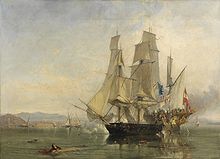 The Action and Capture of the Spanish Xebeque Frigate El Gamo, Clarkson Frederick Stanfield
The Action and Capture of the Spanish Xebeque Frigate El Gamo, Clarkson Frederick Stanfield
One of his most notable exploits was the capture of the Spanish xebec frigate El Gamo, on 6 May 1801. El Gamo carried 32 guns and 319 men, compared with Speedy's 14 guns and 54 men.[12][13] Cochrane flew an American flag to approach so closely to El Gamo that its guns could not depress to fire on the Speedy's hull. This left the Spanish with no option but to board. However, whenever the Spanish were about to board, Cochrane would pull away briefly, and fire on the concentrated boarding parties with his ship's guns. Eventually, Cochrane boarded the Gamo, despite still being outnumbered about five to one, and captured her.
In Speedy's 13-month cruise, Cochrane captured, burned, or drove ashore 53 ships before three French ships of the line under Admiral Charles-Alexandre Linois captured him on 3 July 1801. During his time as a prisoner Linois often asked him for advice and Cochrane later referred to how polite he was in his autobiography. A few days later he was exchanged for the second captain of another French ship. Then, on 8 August 1801, he received a promotion to the rank of post-captain.
After the Peace of Amiens, Cochrane attended the University of Edinburgh. Upon the resumption of war in 1803, St Vincent assigned him in October 1803 to command of a sixth-rate ship which was the 22-gun HMS Arab. Cochrane alleged that the ship had poor handling, colliding with Royal Navy ships on two occasions (the Bloodhound and the Abundance), and afforded Cochrane no opportunities. In his autobiography he would compare the Arab to a collier and his first thoughts on seeing Arab being repaired at Plymouth were that she would "sail like a haystack".[14] Despite this, he still managed to intercept and board an American merchant ship, the Chatham, and create an international incident, leading to the consignment of HMS Arab and her commander to protect Britain's important whaling fleet beyond Orkney in the North Sea.
In 1804, St Vincent stood aside for the incoming new government led by William Pitt the Younger and Henry Dundas, 1st Viscount Melville took office. In December of that year Cochrane received an appointment to command of the new 32-gun frigate HMS Pallas, in which he undertook a series of notable exploits over the following eighteen months.
In August 1806, he took command of the 38-gun frigate Frederick Marryat, who later wrote fictionalized accounts of his adventures with Cochrane.
In Imperieuse Cochrane raided the Mediterranean coast of France. In 1808, Cochrane and a Spanish guerrilla force captured the fortress of Mongat, which sat astride the road between Gerona and Barcelona. This delayed General Duhesme's French army for a month. On another raid Cochrane copied code books from a signal station, leaving behind the originals so the French would believe them uncompromised. When Imperieuse ran short of water, she sailed up the estuary of the Rhone to replenish. When a French army marched into Catalonia and besieged Rosas, Cochrane took part in the defence of the town by occupying and defending Fort Trinidad ('Castell de la Trinitat') for a number of weeks before the fall of the city forced him to leave; Cochrane was one of the last two men to quit the fort.
While captain of Speedy, Pallas, and Imperieuse, Cochrane became arguably the most effective practitioner of coastal warfare during the period. Not only did he attack shore installations such as the Martello tower at Son Bou on Minorca, but captured enemy ships in harbor by leading his men in boats in "cutting out" operations. He was a meticulous planner of every operation, which limited casualties among his men and maximized the chances of success.
In 1809, he commanded the attack by a flotilla of fire ships on Rochefort, as part of the Battle of the Basque Roads. The attack did considerable damage, but Cochrane blamed Admiral Gambier, the fleet commander, for missing the opportunity to destroy the French fleet. Cochrane claimed that as a result of expressing his opinion publicly the admiralty denied him the opportunity to serve afloat. The evidence however shows that he was focussed on politics at this time and, indeed, refused a number of offers of command.[15]
Political career
In June 1806, Cochrane stood for the House of Commons on a ticket of parliamentary reform (a movement which would later bring about the Reform Acts) for the potwalloper borough of Honiton. This was exactly the kind of borough Cochrane wished to abolish; votes were mostly sold to the highest bidder. Cochrane offered nothing and lost the election. In October 1806, he again ran for Parliament in Honiton and won. Cochrane initially denied that he paid any bribes, but he revealed in a Parliamentary debate ten years later that he had paid ten guineas (£10 10s) per voter through Mr. Townshend, local headman and banker.
In May 1807, Cochrane was elected by Westminster in a more democratic election. Cochrane campaigned for parliamentary reform, allied with such Radicals as William Cobbett, Sir Francis Burdett and Henry Hunt. His outspoken criticism of the conduct of the war and the corruption in the navy made him powerful enemies in the government. His criticism of Admiral Gambier's conduct at the Battle of the Basque Roads was so severe that Gambier demanded a court-martial to clear his name. This made Cochrane important enemies in the Admiralty.
In 1810, Sir Francis Burdett, a Member of Parliament and political ally, had barricaded himself in his home at Piccadilly, London, resisting arrest by the House of Commons. Cochrane went to assist Burdett's defence of the house. His approach to this, however, was essentially similar to the approach he had taken in defending forts against enemy attack and would have led to numerous deaths amongst the arresting officers and at least partial destruction of Burdett's house, along with much of Piccadilly. On realising what Cochrane planned, Burdett and his allies took steps to end the siege.
Cochrane, though popular with the public, was unable to get along with his colleagues in the House of Commons, let alone the government. Usually, he had little success in promoting his causes, though there were exceptions: in 1812 he successfully confronted the Admiralty's prize court.
His conviction in the Great Stock Exchange Fraud of 1814 (see below) resulted in Parliament expelling him on 5 July 1814. However, his constituents in the seat of Westminster re-elected him at the resulting by-election on 16 July.[16] He held this seat until 1818. In 1818, Cochrane last speech in Parliament advocated parliamentary reform.
In 1830, Cochrane initially expressed interest but then declined. Not only had Lord Brougham's brother decided to run for the seat, but also Cochrane thought it would look bad for him to be publicly supporting a government from which he sought pardon for his fraud conviction.
In 1831, his father died and Cochrane became the 10th Earl of Dundonald. As such, he was no longer entitled to sit in the Commons; the Scottish peerage elected representative peers to sit in the House of Lords. He was never one of them, though several of his successors were.
Marriage and children
In 1812, Cochrane married Katherine Frances Corbet Barnes, a beautiful orphan, who was about twenty years his junior. This was an elopement and a civil ceremony, due to the opposition of his wealthy uncle Basil Cochrane, who disinherited his nephew as a result. Katherine, whom Cochrane called 'Kate', 'Kitty' or 'Mouse' in letters to her, often accompanied her husband on his campaigns in South America and Greece.
Cochrane and Katherine would remarry in the Anglican Church in 1818, and in the Church of Scotland in 1825. They had six children;[17]
- Thomas Barnes Cochrane, 11th Earl of Dundonald, b. 18 Apr 1814, m. Louisa Harriett McKinnon.[18]
- William Horatio Bernardo Cochrane, officer, 92nd Gordon Highlanders, b. 8 Mar 1818 [19] m. Jacobina Frances Nicholson.
- Elizabeth Katharine Cochrane, died close to her first birthday.
- Katharine Elizabeth Cochrane, d. 25 August 1869, m. John Willis Fleming.[20]
- Admiral Sir Arthur Auckland Leopold Pedro Cochrane KCB (Commander of HMS Niger), b. 24 Sep 1824, d. 20 Aug 1905. m.[21]
- Captain Ernest Gray Lambton Cochrane RN (High Sheriff, Co. Donegal) b. 4 Jun 1834, d. 2 Feb 1911 m. 1. Adelaide Blackall 2. Elizabeth Frances Maria Katherine Doherty.[22]
The confusion of multiple ceremonies led to suspicions that Cochrane's first son, Thomas Barnes Cochrane, was illegitimate, which delayed Thomas's accession to the Earldom of Dundonald on his father's death.
Ancestry
Unless otherwise footnoted, this genealogy has been reproduced from The Peerage.com [23]
Ancestors of Thomas Cochrane, 10th Earl of Dundonald 16. Sir John Cochrane 8. William Cochrane, 7th Earl of Dundonald 17. Margaret Strickland 4. Thomas Cochrane, 8th Earl of Dundonald 18. Alexander Bruce, 2nd Earl of Kincardine [24] 9. Lady Mary Bruce 19. Veronica van Arson [25][26] 2. Archibald Cochrane, 9th Earl of Dundonald 20. Alexander Stuart [27] 10. Archibald Stuart [27] 21. Isabel Nisbet 5. Jane Stuart 22. Sir Andrew Myreton of Gorgar, Bart.[29] 11. Elizabeth Myreton [28] 23. Jean Murray [29] 1. Thomas Cochrane, 10th Earl of Dundonald 24. 12. Walter Gilchrist 25. 6. Captain James Gilchrist, RN 26. Patrick Hamilton of Neilsland 13. Grizell Hamilton of Neilsland 27. 3. Anna Gilchrist 28. John Roberton, 15th Laird of Earnock 14. Major John Roberton, 16th Laird of Earnock[31] 29. Ann Hamilton of Raploch 7. Ann Roberton [29][30] 30. James Hamilton of Dalziel 15. Elizabeth Hamilton 31. Margaret Hamilton of Rosehall The Great Stock Exchange Fraud
Main article: Great Stock Exchange Fraud of 1814In February 1814, rumours of Napoleon's death began to circulate and the claims were seemingly confirmed by a man in a red staff officer's uniform posing as Colonel de Bourg, aide-du-camp to Lord Cathcart and British ambassador to Russia, who arrived in Dover from France on 21 February bearing news that Napoleon had been captured and killed by Cossacks.[32] In reaction to the news and the possibility of peace, share prices rose sharply on the Stock Exchange, particularly in a volatile government stock called Omnium which increased from 26 and a half to 32.[32] However, it soon became clear that the news of Napoleon's death was a hoax. The Stock Exchange established a sub-committee to investigate, and they duly discovered that six men had sold substantial amounts of Omnium stock during the boom in value, and it was assumed that all six were responsible for the hoax and subsequent fraud. Cochrane had disposed of his entire £139,000 holding in Omnium – which he had only acquired a month before – and was named as one of the six conspirators, as was his uncle, Andrew Cochrane-Johnstone and his stock broker, Richard Butt.[32] Within days, an anonymous informant told the committee that Colonel de Bourg was an imposter; he was a Prussian aristocrat named De Berenger and he had been seen entering Cochrane's house on the day of the hoax.[33]
The accused were brought to trial in the Court of King's Bench, Guildhall on 8 June 1814. The trial was presided over by Lord Ellenborough, a High Tory and a notable enemy of the radicals who had previously sentenced radical politicians William Cobbett and Henry Hunt to prison in politically motivated trials.[34] The evidence against Cochrane was inevitably circumstantial (as the prosecuting counsel pointed out) and hinged on the nature of his share dealings, his contacts with those who were clearly conspirators and colour of uniform De Berenger had been wearing when they met in his house.[35] Cochrane admitted he was acquainted with De Berenger and that he had visited his home on the day of the fraud, but insisted he had arrived wearing a green sharpshooter's uniform and had merely called to request passage to the United States aboard Cochrane's new command the HMS Tonnant. Although in a sworn affidavit created before the trial, Cochrane's servants agreed that the collar of the uniform above the greatcoat had been green, they admitted to his solicitors that they thought the rest had been red, and were not called to give evidence.[36] The prosecution summoned a key witness, hackney carriage driver William Crane, who swore that De Berenger was wearing a scarlet uniform when he delivered him to the house.[37] Cochrane's defence also argued that he had given standing instructions to Butt that his Omnium shares were to be sold if the price rose by 1 per cent, and he would have made double profit if he waited until it reached its peak price. Unfortunately, all the conspirators had given identical instructions to their brokers.[38]
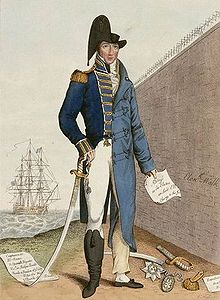 A caricature created in 1815 titled Things as they have been. Things as they now are. The left side of the image depicts Cochrane as a heroic naval officer. The right side depicts him as a disgraced civilian imprisoned within the walls of the King's Bench Prison.
A caricature created in 1815 titled Things as they have been. Things as they now are. The left side of the image depicts Cochrane as a heroic naval officer. The right side depicts him as a disgraced civilian imprisoned within the walls of the King's Bench Prison.
On the second day of the trial, Lord Ellenborough began his summary of the evidence and drew attention to the matter of De Berenger's uniform which he regarded as damning evidence.[39] The jury retired to deliberate and returned a verdict of guilty against all the defendants two and a half hours later. Belatedly, Cochrane's defence team found several witnesses who were willing to testify that De Berenger had arrived wearing a green uniform, but Lord Ellenborough dismissed their evidence as inadmissible because two of the conspirators had fled the country upon hearing the guilty verdict.[39] On 20 June 1814, Cochrane was sentenced to 12 months imprisonment, fined £1,000 and was ordered to stand in the pillory opposite the Royal Exchange for one hour. In subsequent weeks he was also dismissed from the Royal Navy by the Admiralty and expelled from Parliament following a motion in the House of Commons which was passed by 144 votes to 44.[39] On the orders of the Prince Regent, Cochrane was further humiliated by the loss of his knighthood in a degradation ceremony at Westminster Abbey in which his banner was taken down and kicked out of the chapel and down the steps outside.[39] However, within a month, Cochrane was re-elected unopposed as the Member of Parliament for Westminster and following public outcry, his sentence to the pillory was rescinded for fears it would lead to the outbreak of a riot.[40][41]
The question of Cochrane's innocence or guilt created much debate at the time and has divided historians ever since.[42] Subsequent reviews of the trial carried out by three Lord Chancellors during the course of the 19th century concluded that Cochrane should have been found not guilty on the basis of the evidence produced in court.[43] Cochrane maintained his innocence for the rest of his life and campaigned tirelessly to restore his damaged reputation and to clear his name. He believed the trial was politically motivated and that a "higher authority than the Stock Exchange" was responsible for his prosecution.[41] A series of petitions put forward by Cochrane protesting his innocence were ignored until 1830 when King George IV (the former Prince Regent) died and was succeeeded by William IV who had served in the Royal Navy and was sympathetic to Cochrane's cause.[44] Later that year the Tory government fell and was replaced by a Whig government in which his friend, Lord Brougham, was appointed Lord Chancellor.[44] Following a meeting of the Privy Council in May 1832 Cochrane was granted a pardon and restored to the Navy List with a promotion to rear-admiral.[45][46] Support from friends in the government, and the writings of popular naval authors such as Frederick Marryat and Maria Graham increased public sympathy for Cochrane's situation, and in May 1847, with the personal intervention of Queen Victoria, Cochrane's knighthood was restored and he was created a Knight Grand Cross of the Order of the Bath.[47][48][49] Only in 1860 did his banner return to Westminster Abbey; the day before his funeral.[46]
In 1876, his grandson received a payment of £40,000 from the British government, based on the recommendations of a Parliamentary select committee, in compensation for his conviction which was believed to be unjust.[50]
See also: First Chilean Navy SquadronA painting of the Capture of Valdivia in the Chilean naval and maritime museum
Cochrane left the UK in official disgrace, but that did not end his naval career. Accompanied by Lady Cochrane and their two children, he reached Valparaíso on 28 November 1818.
On 11 December 1818, at the request of Chilean leader Bernardo O'Higgins, Cochrane became a Chilean citizen, was appointed Vice Admiral, and took command of the Chilean Navy in Chile's war of independence against Spain. He was the first Vice Admiral of Chile.[51](p37) Cochrane reorganized the Chilean navy, introducing British naval customs. He took command in the frigate O'Higgins and blockaded and raided the coasts of Peru as he had those of France and Spain. On his own initiative he organized and led the capture of Valdivia, despite only having 300 men and two ships to deploy against seven large forts. However, he failed in his attempt to capture the Chiloé Archipelago for Chile. In 1820, O'Higgins ordered him to convoy the Liberation Army of General José de San Martín to Peru, blockade the coast and support the campaign for independence. Later, forces under Cochrane's personal command cut out and captured the frigate Esmeralda, the most powerful Spanish ship in South America. All this led to Peruvian independence, which O'Higgins considered indispensable to Chile's independence and security. Cochrane's victories in the Pacific were spectacular and important but the euphoria was almost immediately marred by accusations that he had been plotted against by subordinates and treated with contempt and denied adequate financial reward by his superiors. It is clear from the evidence that none of these accusations is true and that the root of the problem lay in Cochrane's own suspicious and uneasy personality.[52]
Loose words of Katty resulted in a story that Cochrane have made plans to free Napoleon from his exile on Saint Helena and make him ruler of a unified South American state, a non-sense because Charles, the envoy, was killed two months before his "departure to Europe".[53] Cochrane left the service of the Chilean Navy on 29 November 1822.
The Chilean Navy has named five ships Cochrane or Almirante Cochrane (Admiral Cochrane) in his honour:
- The first, Almirante Cochrane, was a famous battery ship that fought in the War of the Pacific (1879–1884).
- The second Almirante Cochrane was a dreadnought battleship laid down in Britain in 1913. The Royal Navy acquired the unfinished ship in 1917, converting her into to the carrier HMS Eagle (1918).
- The third ship, Cochrane, was a Fletcher-class destroyer, the former USS Rooks (DD-804), commissioned into the Chilean Navy in 1962 and scrapped in 1983.
- The fourth ship, Almirante Cochrane, was a County-class destroyer, the former HMS Antrim (D18), which the Chilean Navy acquired in 1984 and decommissioned in 2006.
- The fifth and current ship to bear the name, Almirante Cochrane (FF-05), is a Type 23 frigate, the former HMS Norfolk (F230), which the Chilean Navy commissioned in 2006.
Brazil was fighting its own war of independence against Portugal. Excepting Montevideo (in today Uruguay, then Cisplatina), along the 1822, the southern provinces fell under the control of the patriots led by the Prince Regent, later Emperor Pedro I, but Portugal still controlled some north important capitals, with major garrisons and naval bases like Belém do Pará, Salvador da Bahia and São Luís do Maranhão.
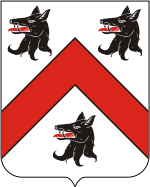 Coat of arms of the Marquess of Maranhão.[54]
Coat of arms of the Marquess of Maranhão.[54]
Cochrane took command of the Brazilian Navy on 21 March 1823 and its flagship, the 'Pedro I'. He blockaded the Portuguese in Bahia, confronted them at the Battle of May 4, and forced them to evacuate the province in a vast convoy of ships which Cochrane's men attacked as they crossed the Atlantic. Cochrane then sailed to Maranhão (then called Maranham) on his own initiative and bluffed the garrison into surrender by claiming that a vast (and mythical) Brazilian fleet and army were over the horizon. He then sent a subordinate, Captain John Pascoe Grenfell, to Belém do Pará to use the same bluff and extract a Portuguese surrender. As a result of Cochrane's efforts, Brazil was now totally de facto independent and free from any Portuguese troops. On his return to Rio de Janeiro, the Emperor Pedro I rewarded him by making him the Marquess of Maranhão (Marquês do Maranhão) in the Empire of Brazil in 1824. He was also awarded an accompanying coat of arms. Although many suggested that the Brazilian title was not hereditary, the descendants of Lord Dundonald preserved the title among themselves.[55]
Unfortunately, as in Chile, Cochrane's joy at these successes was rapidly replaced by quarrels over pay and prize money and a totally imaginary accusation that the Brazilian authorities were plotting against him.[56]
In mid- 1824, Cochrane sailed north with a squadron to assist the Brazilian army, under General Francisco Lima e Silva, suppress a republican rebellion in the state of Pernambuco which had begun to spread to Maranhão and other northern states. The rebellion was rapidly extinguished. Cochrane then proceeded to Maranhão where he took over the administration and demanded the payment of a vast sum of prize money which he claimed was owing to himself and the squadron as a result of the recapture of the province in 1823.[57] He took all money from the public funds and sacked all merchant ships anchored in São Luís do Maranhão.[58] Then, defying orders to return to Rio de Janeiro, Cochrane transferred to a captured Brazilian frigate, left Brazil on 10 November 1825 and returned to Britain.
Cochrane then went to Europe, where between March 1827 and December 1828 he took an active role in the campaign to secure Greek independence from the Ottoman Empire, which had deployed an army raised in Egypt to suppress the Greek rebellion. Cochrane's efforts generally met with limited success due to the poor discipline of the Greek soldiers and seamen. Still, one of his subordinates, Captain Hastings, attacked Ottoman forces at the Gulf of Lepanto, which indirectly led to intervention by Great Britain, France and Russia, the destruction of the Turko–Egyptian fleet at the Battle of Navarino, and the end of the war under mediation of the Great Powers.
Greece was probably the only campaign in Cochrane's naval career in which the results of his efforts were disappointingly slight. At the end of the war he resigned and returned to Britain. For the first time since he was convicted for the 1814 Stock Exchange Scandal his lively nature was brought to a standstill. Despite reports to the contrary, there is little evidence to suggest that he experienced a nervous breakdown.
Cochrane inherited his peerage following his father's death on 1 July 1831, becoming the 10th Earl of Dundonald. He was restored to the Royal Navy list on 2 May 1832 as a Rear Admiral of the Blue, but Cochrane's return to Royal Navy service was delayed by his refusal to take a command until his knighthood had been restored. Nevertheless, he was further promoted up the list of flag officers, as follows:
- Rear Admiral of the Blue on 2 May 1832
- Rear Admiral of the White on 10 January 1837
- Rear Admiral of the Red on 28 June 1838
- Vice Admiral of the Blue on 23 November 1841
- Vice Admiral of the White on 9 November 1846
- Vice Admiral of the Red on 3 January 1848
- Admiral of the Blue on 21 March 1851
- Admiral of the White on 2 April 1853
- Admiral of the Red on 8 December 1857
On 22 May 1847 Queen Victoria reinstated him as a knight in the Order of the Bath. He then served as Commander-in-Chief of the North America and West Indies Station from 1848 to 1851. During the Crimean War, the government considered him for a command in the Baltic, but decided that there was too high a chance that he would lose his fleet in a risky attack. On 6 November 1854, he was appointed to the honorary office of Rear-Admiral of the United Kingdom, an office that he would retain until his death.
In his final years he wrote his autobiography in collaboration with G.B. Earp. With his health deteriorating, in 1860 Cochrane twice underwent painful surgery for kidney stones. He died during the second operation on 31 October 1860, in Kensington.[59] He was buried in Westminster Abbey, where his grave is in the central part of the nave. Each year in May representatives of the Chilean Navy hold a wreath laying ceremony at his grave.[60]
Innovation in technology
Convoys were guided by ships following the lamps of those ahead. In 1805, Cochrane entered a Royal Navy competition for a superior convoy lamp. Believing that the judges to be biased against him, he reentered the contest under another name, winning the prize.[61]
In 1806, Cochrane had a galley made to his specifications, which he carried on board Pallas and used to attack the French coast.[62]
In 1812, Cochrane proposed attacking the French coast using a combination of bombardment ships, explosion ships and "stink vessels" (gas warfare). A bombardment ship consisted of a strengthened old hulk filled with powder and shot and made to list one side. It would then be anchored at night to face the enemy behind the harbour wall. This would allow saturation bombardment of the harbour, which would be closely followed by landings of troops. He put the plans forward again before and during the Crimean War. The authorities, however, decided not to pursue his plans.[63][64]
In 1818, Cochrane patented, together with the engineer Marc Isambard Brunel, the tunneling shield that Brunel and his son used in the building of the Thames Tunnel in 1825–43.
Cochrane was an early supporter of steamships. He attempted to bring steamship Rising Star from Britain to Chile, but its construction took too long; it did not arrive until the war was ending. The Rising Star was a 410 ton vessel adapted to a revolutionary design at Brent's Yard at the Greenland Dock at the Thames: twin funnels, retractable paddle wheels and driven by a 60 horse-power engine.[51](p33) This happened again with a steamship he had hoped to bring to the Greek War of Independence. In the 1830s, he experimented with steam power, developing a rotary engine and a propeller. In 1851, Cochrane received a patent on powering steamships with bitumen.[65]
Fictional references
His career inspired a number of writers of nautical fiction. The first was Captain Marryat who had served under him as a midshipman. In the 20th century, the fictional careers of Horatio Hornblower in the novels by C. S. Forester and of Jack Aubrey in the Aubrey–Maturin series of novels by Patrick O'Brian were in part modelled on his exploits.[66]
Appearance in fiction
- Lord Cochrane's first appearance is in the historical fiction writer G. A. Henty's With Cochrane the Dauntless (1897).
- The novel The Sea Lord (originally The Frigate Captain) by Showell Styles is explicitly about Lord Cochrane.
- In the alternate history series The Domination by S.M. Stirling,[67] Lord Cochrane leads the occupation of Cape Colony.
- The novel Sharpe's Devil by Bernard Cornwell features an episode from Cochrane's time in Chile.[68]
- Lord Cochrane is a minor character in Manuela (ISBN 0-9704250-0-7) by Gregory Kauffman, a novel about the South American revolution.
See also
- John Dundas Cochrane, his cousin.
- Admiral Sir Alexander Forrester Inglis Cochrane, his uncle.
- Sir Thomas John Cochrane Vice-Admiral of the United Kingdom and Governor of Newfoundland, his cousin.
- Notable Royal Navy Officers of the Napoleonic Wars
Notes
- ^ The heir-apparent to an earldom uses the Earl's next-highest title as a courtesy title; see Earl for details.
- ^ Even after he had inherited the title of Earl of Dundonald in 1831, he was often still referred to as Lord Cochrane.
- ^ Cordingley, p.10.
- ^ The Peerage website
- ^ Cordingley, p.20.
- ^ Families of the 8th and 9th Earls
- ^ Cordingley, p.19 & p.21.
- ^ Cordingley, p.25.
- ^ a b Cordingley, p.21.
- ^ a b Cordingley, pp.22–24.
- ^ Cordingley, pp.28–29.
- ^ Cordingly p.58.
- ^ London Gazette: no. 15393. p. 949. 1801-01-08. Retrieved 2010-07-16.
- ^ Cochrane Britannia's Sea Wolf, Thomas, p.82
- ^ Vale, Brian, 'The Audacious Admiral Cochrane', Conway 2004, p. 63-72
- ^ Leigh Rayment's peerage page
- ^ Peerage website
- ^ Children of Admiral Sir Thomas Cochrane, 10th Earl of Dundonald and Katherine Frances Corbett Barnes
- ^ Children of Admiral Sir Thomas Cochrane, 10th Earl of Dundonald and Katherine Frances Corbett Barnes
- ^ Children of Admiral Sir Thomas Cochrane, 10th Earl of Dundonald and Katherine Frances Corbett Barnes
- ^ Children of Admiral Sir Thomas Cochrane, 10th Earl of Dundonald and Katherine Frances Corbett Barnes
- ^ Children of Admiral Sir Thomas Cochrane, 10th Earl of Dundonald and Katherine Frances Corbett Barnes
- ^ Admiral Thomas Cochrane, 10th Earl of Dundonald
- ^ Bourke, J A General and Heraldic Dictionary of the Peerage and Baronetage of the British Empire Vol I p 432 [1]
- ^ The Peerage
- ^ Maidment J 1845 Vol II p 212 A Spottiswoode Miscellany
- ^ a b Brydges E 1812 Collins' Peerage of England Vol. VIII p 435 at
- ^ The Stirnet Project
- ^ a b c Familysearch
- ^ The Stirnet Project [ www.stirnet.com/HTML/genie/british/qr/roberton02.htm]
- ^ Earnock and its Early Proprietors, Hamilton Advertiser, n.d. July 1874
- ^ a b c Vale (2004) p.74.
- ^ Cordingly p.241.
- ^ Cordingly p.243.
- ^ Vale (2004) p.78.
- ^ Dale, Richard, 'Napoleon is Dead: Lord Cochrane and the Great Stock Exchange Scandal', Sutton 2006
- ^ Cordingly p.244.
- ^ Vale (2004) p.77.
- ^ a b c d Cordingly p.250.
- ^ Vale p.81.
- ^ a b Cordingly p.251.
- ^ Cordingly pp.251–252.
- ^ Cordingly p.352.
- ^ a b Cordingly p.334.
- ^ London Gazette: no. 18934. p. 1017. 8 May 1832.
- ^ a b Cordingly p.335.
- ^ Vale (2008) pp.193–194.
- ^ Cordingly pp.343–344.
- ^ London Gazette: no. 20736. p. 1870. 25 May 1847.
- ^ Thomas, Donald (1997). Cochrane: Britannia's sea wolf. Naval Institute Press. p. [page needed]. ISBN 978-1557508089.
- ^ a b Brian Vale, Cochrane in the Pacific, I.B. Tauris & Co Ltd, 2008, ISBN 978 1 84511 446 6
- ^ Vale, Brian, 'Cochrane in the Pacific', I. B. Tauris 2008
- ^ Vale, Brian, 'Cochrane in the Pacific', I. B. Tauris 2008, page 205
- ^ VASCONCELOS, Jaime Smith & VASCONCELOS, Rodolfo Smith. Archivo Nobiliarchico Brasileiro. Lausanne, 1918.
- ^ Burke's Peerage
- ^ Vale, Brian 'Independence or Death! British Sailors and Brazilian Independence', I. B. Tauris, 1996
- ^ Vale, 1996
- ^ Gomes, Laurentino. "1822". Nova Fronteira, São Paulo, 2010
- ^ Vale, Brian (2008). Cochrane in the Pacific: Fortune and Freedom in Spanish America. I. B. Tauris. ISBN 1845114469.
- ^ Westminster Abbey
- ^ Cordingly p.337
- ^ Gardner p.108
- ^ Cordingly p. 337
- ^ Grimble pp. 384–417
- ^ Cordingly p.346
- ^ King, Dean, 2000, Patrick O'Brian: A Life Revealed,p. 193, Henry Holt & Co, New York ISBN 0-8050-5976-8
- ^ S.M. Stirling, The Domination (Omnibus edition of first 3 works) ISBN 0-671-57794-8
- ^ Bernard Cornwell, Sharpe's Devil: Chile 1820 (Sharpe's Adventures) ISBN 0-06-093229-5
References
- Cordingly, David (2007). Cochrane The Dauntless: The Life and Adventures of Thomas Cochrane. New York: Bloomsbury Publishing. ISBN 978-0-7475-8545-9.
- Gardner, Robert (2000). Frigates of the Napoleonic Wars. London. ISBN 1557502889.
- Grimble, Ian (2000). The Sea Wolf: The Life of Admiral Cochrane. Edinburgh: Birlinn. ISBN 978-1841580357.
- Vale, Brian (1996). Independence of Death! British Sailors and Brazilian Independence. I.B.Tauris. ISBN 1860640605.
- Vale, Brian (2004). The Audacious Admiral Cochrane. Conway Maritime Press. ISBN 978-0851779867.
- Vale, Brian (2008). Cochrane in the Pacific: Fortune and Freedom in Spanish America. I.B.Tauris. ISBN 9781845114466.
Further reading
- Cochrane, Alexander, in collaboration with the 14th Earl of Dundonald, "The Fighting Cochranes: A Scottish Clan over six hundred years of naval and military history" 1983, Quiller Press, London, ISBN 0-907621-19-8
- Dale, Richard. "Napoleon is Dead: Lord Cochrane and the Great Stock Exchange Scandal" (2006) London: Sutton Pub., 256pp, ISBN 978-0-7509-4381-9
- Davie, Donald. Poem entitled 'Lady Cochrane' in "Collected Poems 1971–1983". 1983, Manchester: Carcanet Press, ISBN 0-85635-462-7 and Mid Northumberland Arts Group ISBN 0-904790-30-4. U.S. edition 1983, Notre Dame, Indiana: University of Notre Dame Press, ISBN 0-268-00745-4
- Dundonald, Thomas. Cochrane, Earl of, 1775–1860. The Autobiography of a Seaman. Introduction by Richard Woodman.
New York: Lyons Press, 2000. ISBN 1-86176-156-2 - Earnock and its Early Proprietors, nd Hamilton Advertiser, n.d. July 1874
- Harvey, Robert. Cochrane: The Life and Exploits of a Fighting Captain. New York: Carroll & Graf, 2000. ISBN 0-7867-0923-5
- Harvey, Robert. "Liberators: Latin America`s Struggle For Independence, 1810–1830". John Murray, London (2000). ISBN 0-7195-5566-3
- Lloyd, Christopher Lord Cochrane. Seaman, Radical, Liberator. – A Life of Tomas Lord Cochrane 10th Earl of Dundonald. 1775–1860, ISBN 0-8050-5986-5
- Stephenson, Charles. "The Admiral's Secret Weapon: Lord Dundonald and the Origins of Chemical Warfare" (2006) Boydell press, ISBN 978-1-84383-280-5
- Thomas, Donald. Cochrane: Britannia's Sea Wolf. 2nd Edition 2001, Cassell Military Paperbacks, London, 383pp, ISBN 0-304-35659-X
External links
- Spartacus Educational – Thomas Cochrane
- BBC UK
- Gazeteer for Scotland – Thomas Cochrane
- Royal Navy – Admiral Lord Thomas Cochrane, 10th Earl of Dundonald 1775–1860
- Napoleonic Guide – Thomas Cochrane
- Works by Thomas Cochrane at Project Gutenberg
- The Trial of Charles Random de Berenger, Sir Thomas Cochrane et al. taken in shorthand by William Brodie Gurney, from Project Gutenberg
- Project Gutenberg edition of The Life of Thomas, Lord Cochrane, Tenth Earl of Dundonald, G.C.B., Admiral of the Red, Rear-Admiral of the Fleet, Etc., Etc by his son, Thomas, Eleventh Earl of Dundonald and H.R. Fox Bourne
- Henty's With Cochrane The Dauntless at Project Gutenberg
- See full details of his family at thePeerage.com
- Archival material relating to Thomas Cochrane, 10th Earl of Dundonald listed at the UK National Register of Archives
Military offices Preceded by
Sir Francis AustenCommander-in-Chief, North America and West Indies Station
1848–1851Succeeded by
Sir George SeymourHonorary titles Preceded by
Sir William Hall GageRear-Admiral of the United Kingdom
1854–1860Succeeded by
Sir Graham Eden Hamond, 2nd BaronetPeerage of Scotland Preceded by
Archibald CochraneEarl of Dundonald
1831–1860Succeeded by
Thomas Barnes CochraneTitles of nobility of the Brazilian Empire New title Marquess of Maranhão
1824–1860Extinct Categories:- Royal Navy admirals
- Earls in the Peerage of Scotland
- History of Brazil
- History of Chile
- Knights Companion of the Order of the Bath
- Recipients of the Order of Merit (Chile)
- Members of the United Kingdom Parliament for English constituencies
- People from South Lanarkshire
- Scottish admirals
- Chilean admirals
- Scottish Episcopalians
- British naval personnel of the French Revolutionary Wars
- British naval commanders of the Napoleonic Wars
- People of the Chilean War of Independence
- Philhellenes
- People of the Greek War of Independence
- Burials at Westminster Abbey
- Brazilian military personnel
- People of the Spanish American wars of independence
- People of the Latin American wars of independence
- UK MPs 1806–1807
- UK MPs 1807–1812
- UK MPs 1812–1818
- 1775 births
- 1860 deaths
- Recipients of British royal pardons
- Deaths from surgical complications
- British politicians convicted of fraud
- British politicians convicted of crimes
- Duellists
Wikimedia Foundation. 2010.

